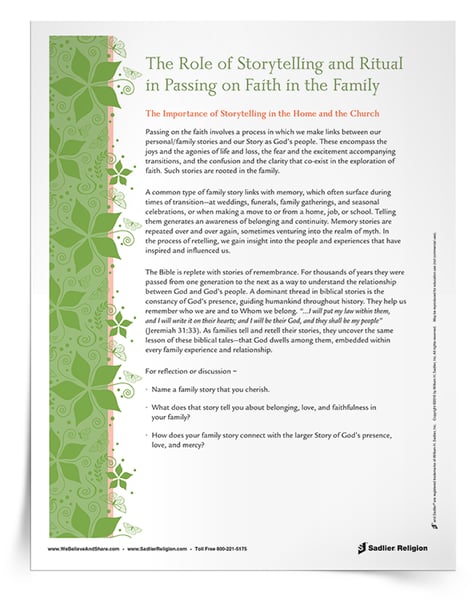May 22, 2019 WBAS Topics For Families, WBAS Whole Community Catechesis, REL Topic - Catechesis, REL Asset - Handout, REL PD - Leaders, REL PD - Family Faith
How Parish Catechetical Leaders Can Engage Families with Rituals of Faith by Sharing Stories
By: Kathy Hendricks
If I had to name a single issue around catechesis that crops up again and again as I traverse the country, it’s how to equip catholic families to share and form faith in the home. I offer a number of presentations on this topic and all of them connect in some way to the importance of telling stories.
At first glance this might not seem very helpful. Shouldn’t parents be teaching children prayers, telling them about our religious teachings and practices, and encouraging them to make good choices about how to live and ways to love and serve others? Of course. But it’s important to remember that catechesis in the home is non-structured. Thus the flow of family life is where the richest catechesis takes place. And the telling of stories plays a big role in the passing on of faith.
Download The Role of Storytelling and Ritual in Passing on the Faith in the Family Faith Fact now!
Equipping Catholic Families to Pass on the Faith
In this article I will explore the role story telling plays in passing on the faith and how Parish Catechetical Leaders can engage families with rituals of faith by sharing stories. Included is a printable handout catechetical and school leaders can give directly to their catechists, teachers, and parents to explain and execute this idea of the strength of stories and their connection to rituals of faith. Equipping Catholic families to integrate stories and rituals into their family life starts with leadership modeling how to make connections between the stories and rituals of the home and those of the Church.
As you read this article, reflect on the following questions:
-
What family stories hold meaning for you? What do they say to you about God’s presence and grace?
-
What have your family rituals taught you about the way we celebrate liturgy and the sacraments?

Connecting Our Stories to a Larger Story
In the introduction to her book, Kitchen Table Wisdom (Riverhead Books, 1994), Rachel Naomi Remen emphasizes the connectivity within our stories. “Hidden in all stories is the One Story. The more we listen, the clearer that Story becomes.” Stories remind us of our common humanity and telling them, Remen says, “weaves us into a family once again.”
The electronic media has given us even greater access to the story of our commonality. Thus, my story can be connected with that of another mother halfway across the world. The downside is that, as our cultural obsession with reality TV and celebrity-watching increases, we tend to relish knowing the worst parts of other peoples’ stories. Even feel-good accounts can lack the depth of a story that is told and retold in order to mine its significance.
Passing on the faith involves a storytelling process in which we make links between our personal/family stories and our Story as God’s people. These encompass the joys and the agonies of life and loss, the fear and the excitement accompanying transitions, and the confusion and the clarity that co-exist in the exploration of faith. Such stories are rooted in the family.
How Family Stories Help to Pass on the Faith
What do family stories have to do with handing on the faith? For one thing, they teach us something vital about the meaning in life. In her book, Thin Places, A Pilgrimage Home (Columbia University Press, 2009), anthropologist Ann Armbrecht describes her experience of living in Nepal among people who continually tell tales of their ancestors. Stories, she says, are the way we make sense of our lives. “They are what we tell ourselves and others about who we are and what we want, about where we are going and why. They provide a fixed point, a secure place from which we can step into the world.”
The repetitious nature of family stories is reflected in the way we go about formal catechesis in the Church. We tell and retell the great Story of our tradition – of the mystery of creation, of Jesus’ life, teaching, death, and resurrection, of the Spirit’s life-giving presence. In each retelling, layers of meaning are uncovered as we mature in understanding and commitment to our faith. This allows us to make deep connections between our everyday and “peak” experiences and those of our religious beliefs, values, practices, and traditions. Following in the steps of our ancestors, we pass along our religious Story to succeeding generations, not just with words, but also through witnessing the love and compassion of Christ.
Stories also connect us with something larger than ourselves – our place within our nuclear and extended families as well as within generations of believers who have preceded us. Stories may also provide us with a deeper understanding of our upbringing. Coming in touch with the latter sheds light on the images we form of God, the manner in which we either cherish or disregard religious tradition, the values we embrace, or the choices we make. This is why writing one’s spiritual autobiography is an essential exercise for spiritual direction.
Walter Brueggemann, the Hebrew scripture scholar, says that children need to know stories of their faith tradition so that they can recognize their place within it. This means that they become active participants in the process by not only hearing the stories but also by telling spiritual stories in their own words and by bringing them to life through works, attitudes, and behaviors that contribute to a more loving and just world.
Moving From Family Stories to Family Rituals
In addition to emphasizing the need for children to hear and receive the stories of their faith tradition, Brueggemann, also stresses the need to celebrate them. This most often occurs during religious rituals, another process that is grounded in the home.
A ritual is a patterned way of doing something, one that is honed through repetition. The use of symbols becomes familiar through consistent use and their connection with particular days and seasons. Such repetition creates a sense of identity within our family, ethnic group, church, or society. Rituals also provide stability and comfort during times of grief or trauma. “Getting back to normal” often means that we can celebrate the way we used to with familiar rituals, symbols, and traditions.
The use of rituals is an important way that families pray together. Through them we express our spiritual and religious values. We give thanks, acknowledge our need for one another, and celebrate our blessings. There is a strong link between domestic traditions and those that take place at church. Home ritual make Sunday worship all the more meaningful because it contains symbols that have tremendous power to convey meaning and mystery.
Children come to learn the meaning of seasons and holidays, not in wordy explanations, but through their participation with parents and grandparents, siblings, cousins, and friends as they prepare, share, and later recollect each one. Repeating these celebrations with the turning of each year’s cycle further reinforces a child’s knowledge, appreciation, and recognition of these rituals and the stories that accompany each one. “Even when children do not understand the logic that shapes a particular event, they intuit the meaning of the celebration by processing the sounds, sights, smells, rhythms, and emotions of the experience” (Karen Marie Yust, Real Kids, Real Faith, Jossey-Bass, 2004).
I can attest to this in a very personal way. While my parents were not particularly conscious of it, they provided my siblings and me with a profound experience of the liturgical year by making our home the center of family gatherings. Many of these revolved around seasons and holidays, ones celebrated in ritualistic fashion. Out came the “tools” for particular holidays – the good china for Thanksgiving, and red, white, and blue paper plates for the Fourth of July. We baked or barbecued according to custom, and dressed up or down to create the environment and mood appropriate to the season. These experiences formed an essential groundwork for my later experience of Catholic worship as well as for the ways in which I would introduce my own children to rituals and the celebration of our family and communal story.
It may not have registered at the time, but the stories and rituals of my childhood were an experience of growing up and into my faith, a way to look at who I was and where I belonged. I realize now that I began in just the right place – home – and ventured outward into a wider world. Later, my children helped me recognize the touchstones that stories provide at each stage of life. These not only recall the past but also give us the impetus to live, as Remen puts it, “a life worth remembering.” Rituals help to integrate the meaning of our personal story with our collective one. Taken together, story and ritual provide a powerful foundation for growing faith for a lifetime. It is only natural that the seeding place for each is the home.
MAKING CONNECTIONS
-
PARISH CATECHETICAL LEADERS– When bringing families together for sacramental preparation or for intergenerational gatherings, set aside time for them to share personal stories and rituals. Equipping Catholic families to integrate stories and rituals into their family life may require you help them initially make connections between the stories and rituals of the home and those of the Church.
-
CATHOLIC SCHOOL LEADERS– As we enter into spring and the Easter, invite families to share stories about their favorite Easter traditions. Gather these together to share in a school newsletter and then make a connection between Easter joy and the new life promised to us through Christ.
RESOURCE IDEAS
-
Visit the Family Center at Sadlier Religion for activities, prayers, and ideas for sharing faith in the home. Use the filter on the left side of the home page to sort out material to share with families in your parish or school.
-
Download The Role of Storytelling and Ritual in Passing on the Faith in the Family Faith Fact and give it directly to catechists, teachers, and parents to explain the strength of stories and their connection to rituals of faith. This faith fact will equip Catholic families with the necessary information to make connections between stories and rituals in their homes.





